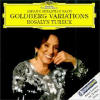Texte paru dans: / Appeared in: |
||||
|
Reviewer: Stephen
Plaistow
Forty years ago,
when Rosalyn Tureck recorded the Goldberg Variations on two LPs for HMV
(2/58), performances in public either by harpsichordists or pianists at the
technical and musical level Tureck consistently attained were as rare as
hen’s teeth. It was a time when, in this country, to hear a harpsichordist
having a shot at the Goldberg was considered a treat, and the passages – not
infrequent – when the player seemed to be having trouble with some barbed
wire had to be accepted as par for the course. George Malcolm was better, of
course, but with him too one was obliged to accept the weird and wonderful
modern instruments that harpsichordists considered then to be the only ones
suitable for concerts and recording. For the public, and certainly for the
record-buying public, the Goldberg Variations were still in deep sleep.
In her 84th
year, 40 years on, Tureck has recorded the work again. The world of Bach
performance meanwhile has changed. It would be wrong to suggest she hasn’t
changed with it but what was striking and specially admirable then calls these
days for less notice. The precision of her articulation and her superfine
control of part-playing are as impressive as ever, but one would not expect
anything less and now other players also provide them. For me, it is the
refinement of her touch which is specially distinctive and immediately apparent
and good to meet again. And the concentration of her playing (which was always
remarkable) is, I think, even greater. If asked to point to her at her best I
would select the nine canonic variations where her delineation of the
intertwining voices, imitating and shadowing each other, is wonderfully
colourful and alive. Try Var. 12, for instance (disc 1, track 13 – the Canon at
the interval of a fourth): what firmness the playing has in its resolve, what
tightness of focus, and what skill there is in the execution. |
||||
|
||||
|
|
|
|||
|
Cliquez l'un ou l'autre
bouton pour découvrir bien d'autres critiques de CD |
||||



